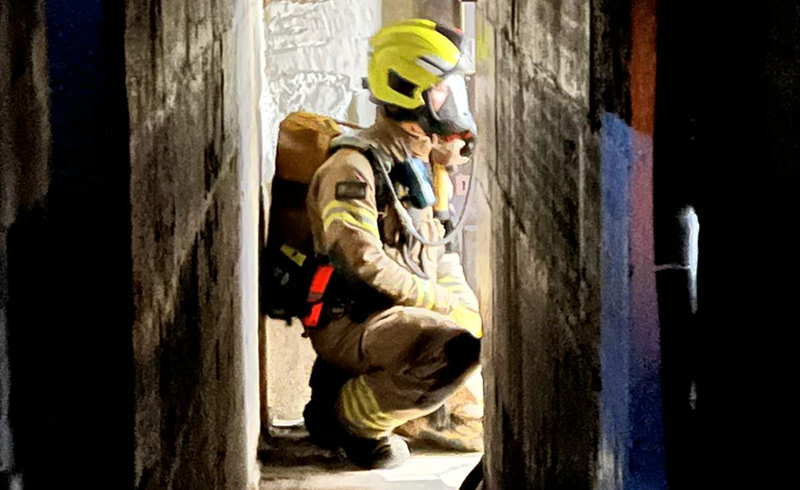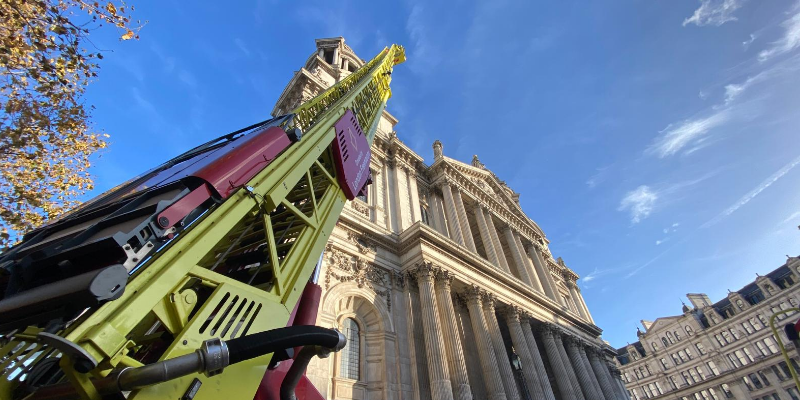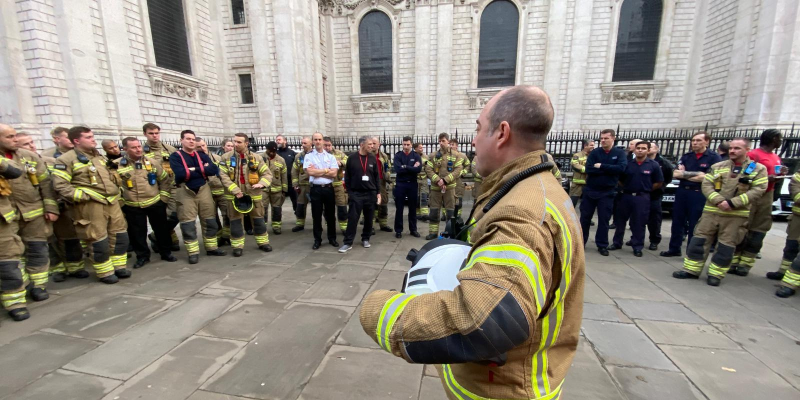Earlier this month we carried out a fire evacuation and salvage exercise at St Paul's Cathedral. This was designed to test firefighters' response to an incident at the Cathedral.
One team was tasked with rescuing casualties from the Cathedral's narrow, winding passages and staircases.
Others were faced with saving the Cathedral's historic (and flammable) domed roof. To do so, they utilised one of the Brigade's 64-metre turntable ladders, which are among the tallest in Europe. The ladder helped the team to gain a better view of the 'fire'. Drone technology was also used to identify hotspots - important for rescuing casualties who were in hard-to-reach locations within the Cathedral. A third team worked closely with St Paul's staff to salvage key artefacts from the Crypt and Galleries.
The exercise concluded with a debrief and a round-up of learning about the building and how to respond most effectively to an incident at the Cathedral. Partners from St Paul's Cathedral, the local council and observers each contributed to the exercise and gave their feedback.

Group Commander Jim Chapman, leading the exercise, said: "It's vital we make every effort to plan for the worst - exercises like this help us to protect national landmarks like St Paul's Cathedral - both the building, its artefacts and most importantly its visitors. This is even more important given the devastating impact of fire at Notre Dame Cathedral in Paris."
In 2019, a blaze raged through the Parisian cathedral, destroying its roof and spire. The fire prompted the Brigade to write to venue owners across London, urging them to consider emergency response planning to protect their buildings and the precious items they contain.
Thousands of historic items in London are at risk of being lost forever if venues do not have the correct salvage plans in place, the Brigade has warned. The Brigade has a dedicated Heritage team, who regularly work closely with cultural and historic venues, and carry out drills to rehearse the response to an incident such as fire or flood.
A salvage plan identifies not only what actions should be implemented by on-site representatives, but also clearly identifies priority items that need to be removed from the building, or protected in place, and allows fire crews to put recovery strategies in place in advance. Plans help firefighters decide what equipment is needed to safely recover or protect items as swiftly as possible and minimise damage. Salvage plans should include ‘Grab Sheets’ which contain vital information about the size of an item, the number of people required to lift it and the location of the item – having this in place can help firefighters save time in a fire or flood.

Every museum, gallery and historic building should have a nominated person responsible for the salvage plan, making sure that a plan exists and is kept up to date. A member of the Brigade’s Heritage Team can provide advice and guidance in relation to salvage planning for organisations who need support.
There are estimated to be around 20,000 listed buildings in London, including many national landmarks, attractions, and historic properties, which are home to some very important items of historical value. London Fire Brigade attended 1,365 fires at or near heritage sites in the last four years and 10 fires at cultural venues such as a museum or art gallery. Nationally there’s an average of around one hundred fires at heritage sites a month.

A spokesperson for our Heritage Team said: “With so many heritage sites in the capital part of our role is to preserve them for the next generation.
“We can’t preserve these beautiful and iconic landmarks without the venues themselves working with us to have emergency salvage plans in place. All building managers need to be aware how important it is to have a plan should the worst-case scenario ever occur. We welcome those people getting in touch with our dedicated team so we can ensure that the plans are appropriate both for the location and our crews, should they ever get a 999 call to attend an incident.”
Our heritage webpages offers a wealth of information and resources for building managers seeking help and support on protecting their buildings to keep them safe for future generations.